For Mala Tempora, the insert is a Weyland file on known cyber-terrorist Reina Roja. The summary at the bottom marks her as being the prime suspect in the Phillips case. So now we have a who, and potentially a how, although the why is not completely clear yet. For now, we will have to dig a bit deeper as we look into the cards from this pack.
Reina Roja: Freedom Fighter
The first (and only) runner identity of this cycle is the aforementioned Reina Roja, or Red Queen. Interestingly, she has both the cyborg and g-mod subtypes on her identity, although we have yet to see any cards that relate to identity subtypes. At any rate, she has the standard 45 card minimum deck size and 15 influence, plus she starts with a base link strength of 1. But her ability is intriguing. She increases the rez cost of the first piece of ice rezzed each turn. This one extra credit can throw off the corporation's early game somewhat, allowing you a bit more access early on. Of course, utilizing this ability that early means taking some risks in what you run into, unless you expose the ice to find out where it is safer to push. Still, the ability becomes less useful as the game moves onward, unless you derez the corporation's ice repeatedly.
Trivia: Reina Roja is the protagonist in the novella Monster Slayer, by Daniel Lovat Clark. Her endless war takes her up against the Weyland Consortium, and in specific, GRNDL.
Pair cards: Forged Activation Orders, Infiltration, Crescentus, Xanadu, Social Engineering, Cyber Threat
Deep Red
Getting 3 memory for 2 credits is possibly the best deal so far. Of course, there is a catch. In this case, that memory can only be used on Caïssa programs. Although, if you have already installed them before you install this, then you are allowed to utilize the memory from this console for those programs. Plus, while this is installed, when you install a Caïssa program, you can use its movement ability without spending a click, which can save you a click on the turn you install it. As such, if you are intending to make significant use of Caïssa programs, you should probably include this console.
Trivia: The name is in reference to Deep Blue, a computer developed by IBM for playing chess. In its debut, it defeated chessmaster Gary Kasparov on February 10, 1996, although Kasparov would win 3 games and played to a stalemate in 2 more, giving him the victory in that match. After numerous upgrades, it played against Kasparov again in May of 1997, winning 3 games and stalemating in 1 to take that match.
Pair cards: all Caïssa programs
Knight
The Caïssa suite now has an icebreaker, although it is somewhat situational. For just 2 credits, you can break any piece of ice with 7 or less strength, but it will cost you 2 credits per subroutine. In addition, this card moves around ice like the chess piece it is named for. If it is already on a piece of ice, it can only be hosted on ice not directly before or after the piece of ice it is already on, meaning it has to jump over ice, or between servers. Still, the sheer power of this breaker could be just what you need to get through that troublesome huge piece ice. For example, compare using this to a Gordian Blade to break a Tollbooth. With Gordian Blade, you will be spending 7 credits in total, but with Knight, it only costs you a total of 5 credits. Or compare it to Corroder to breaking a Hadrian's Wall with no counters. The Corroder will cost 7 credits to break this, while Knight will only cost 4 credits. So, this could be a decent icebreaker in a pinch. Just watch out for Swordsman and other ice that does not play well with AI icebreakers. Also, be aware that because you can only host one Caïssa program on a piece of ice, you can not combo this well with a Bishop.
Pair cards: e3 Feedback Implants, Clone Chip, Self-modifying Code, Deep Red
Running Interference
Not seen very often, this card has the potential to drain the corporation of their credits, or allow you unfettered access to a server. It is a double event, so you do have to spend an extra click. But then you get to make a run, and during that run, the corporation has to spend an additional number of credits equal to the rez cost of a piece of ice in order to rez that ice. So basically, this doubles the rez cost of every unrezzed piece of ice on the server. If the corporation wants to keep you out, they may have to spend a great deal of money doing so, which could make other servers vulnerable. Or if the corporation has no money to begin with, this could prevent them from bringing even relatively cheap ice online. Still, the cost is pretty high, but in the Criminal faction, there are plenty of ways to make money.
Trivia: It turns out this is a reprint. From the Classic expansion to the Netrunner CCG, we have Running Interference, which functions exactly the same as this card, right down to being a double event. The only difference is that the older version only cost 2 credits to play.
Pair cards: Crescentus, Emergency Shutdown, Planned Assault, Public Terminal
Expert Schedule Analyzer
Well, this card is decidedly interesting. It allows you to make a run on HQ, and if that run is successful, then instead of accessing cards, you can reveal all cards currently in the corporation's hand. I suppose this is useful if you suspect the corporation is holding agendas in hand, so you can confirm if that is the case before you commit to a Legwork run. Or if you think they are holding traps in hand, you can use this to confirm that without actually having the danger of hitting those traps. You do still have to get into HQ though, and because this is built into the card, it can not be combined with an Inside Job or with Sneakdoor Beta, but if you think you can easily get into HQ reliably, this could be quite good.
Trivia: And yet another reprint. From the Netrunner CCG, we have Expert Schedule Analyzer, which allows you to look at all the cards in HQ after you access cards from HQ. It also is free to install, so it is not an exact reprint.
Also, the flavor text is likely be a reference to G.I. Joe: A Real American Hero.
Pair cards: Datasucker, Gabriel Santiago: Consummate Professional, Desperado, HQ Interface, John Masanori
Grifter
There is some potential here. If you know you can make at least 1 successful run each turn, then the added economy from this could help sustain future runs. Of course, if you are unable to make a successful run in a turn, then you are forced to trash this card. As such, you will want to install this card either in the early game, before the corporation has fully set up their defenses, or in the late game, when the runner can more easily break into the corporation's servers.
Pair cards: Datasucker, Desperado, Dirty Laundry, John Masanori, Security Testing
Torch
So the obvious comparison to make is with the other major decoder in Shaper, Gordian Blade. By spending 5 extra credits, this card gets 2 additional strength, but loses the ability to keep its strength up for the rest of the run. Why would you want to spend that extra money for a slightly stronger icebreaker? Again, let us go back to Tollbooth. As we have already established, it costs a total of 7 credits to get through a Tollbooth by using a Gordian Blade. But with Torch, that cost is reduced to 5, saving you 2 credits. Of course, if the corporation has set up multiple large code gates, Gordian Blade could start to win out. Breaking 2 Tollbooths in a row costs 11 for Gordian Blade, and 10 for Torch. At 3 Tollbooths in a row, you finally break even, spending 15 credits for either Gordian Blade or Torch. Or perhaps let us try a different code gate. With DNA Tracker, it costs 7 to break one with Gordian Blade, but only 5 with Torch. 2 DNA Trackers in a row, it costs 10 for Gordian Blade and 10 for Torch. At 3 DNA Trackers in a row, Gordian Blade finally wins out, costing 13 credits to the 15 credits for Torch. As such, the advantage of Torch comes from dealing with a single higher strength code gate more easily. Or perhaps, to put it another way, this is a Cyber-Cypher you can use on every server.
Pair cards: Modded, Test Run, Scavenge
Woman in the Red Dress
As I have probably stated before, Netrunner is a game of hidden knowledge. The less the runner knows, the more likely the corporation is to succeed. With this card, you can gain some knowledge into what is in the corporation's deck. At the start of your turn, you reveal the top card of R&D. Then the corporation may choose to draw that card. So if you reveal something inconsequential, such as a piece of ice or an operation, you could choose to ignore R&D for that turn if the corporation does not draw the card. Or if you reveal an agenda and the corporation chooses to draw it, then you know that they have at least 1 agenda in their HQ, and could focus on that server. Still, this card does give additional cards to the corporation, which could give them an advantage over you, so be careful.
Trivia: The card is a reference to The Matrix, specifically the scene where Morpheus is explaining the system to Neo, and asks him, "Were you listening to me, Neo, or were you looking at the woman in the red dress?"
Pair cards: Hostage, Career Fair, Laramy Fisk: Savvy Investor
Raymond Flint
Bad publicity is always beneficial to the runner. Most corporations tend to go out of their way to avoid it, though sometimes they choose to just pile it on, hoping the short term gains will outweigh the long term losses. With this card, you can take greater advantage of the corporation gaining bad publicity. While this is installed, whenever the corporation takes at least 1 bad publicity, you get to access a card from HQ. As such, the corporation may become more hesitant it taking bad publicity, as you could steal agendas from them on their turn. Or you could build a deck around giving bad publicity to the corporation, and take cards from their hand without even making a run. Plus, at practically any time, you can trash Raymond Flint to expose one of the corporation's cards. This could be used to determine if the card with 3 counters you are running towards is either a trap or an agenda. Or you could reveal a piece of ice so you can know if the corporation can rez it and if you can afford to break it. Of course, Raymond Flint is unique, so you can only have one copy installed at a time, but that one could make or break a run.
Trivia: Raymond Flint is one of the 5 playable detectives from the Android board game. His intuition gives him insight into the cases, helping him piece together the conspiracy behind the murder. Unfortunately, he is burdened by his past as a Striker pilot during the war, as his liaison with a woman resulted in the death of one of his comrades, and the disappearance of another. This trauma has led to him becoming an alcoholic, in an attempt to block off his memories.
Raymond Flint is also a minor character in the novel Free Fall, by William H. Keith. Captain Richard Harrison attempts to bring him into a murder case, but Flint refuses to participate when he learns the crime scene is Challenger Planetoid, as being in microgravity is one of the triggers for his memories.
Pair cards: HQ Interface, Frame Job, Hostage, Activist Support, Tallie Perrault, Investigative Journalism
Isabel McGuire
There is a lot of untapped potential to this card that has not been exploited by players. By spending 1 click, you can add 1 of your installed cards back to HQ. Why would you want to do that? Well, suppose the runner has placed a Parasite or a Femme Fatale on a key piece of ice. Normally, to take away their advantage, you would have to overwrite that ice. But with Isabel, you can return that ice to your hand and reinstall it later. Or suppose your Adonis Campaign will run out of money on your next turn. With Isabel, you can return that Adonis Campaign to your hand and reinstall it to gain more cash. Or perhaps you tried to hit the runner with an Aggressive Secretary, but they exposed the card. Well, with Isabel, you can return that Aggressive Secretary to your hand, which will lead the runner to wonder if the next card you install and advance is that Aggressive Secretary, or actually an agenda. Still, in order to do all of this, you have to dedicate slots in your deck to Isabel McGuire, which can be a difficult prospect as many decks are fairly tight already.
Pair cards: Executive Boot Camp, Tech Startup, Executive Search Firm
Hudson 1.0
Cheap to rez, and fairly strong, this code gate does not outright stop the runner. Instead, this card can shut down an attempt to access several cards at once. If the runner can not break this, then they are not allowed to access more than one card during the run. That can prevent deep digs into R&D from Medium or R&D Interface, or from them finding out most of what you are holding from Legwork. Of course, this does have the ability allowing the runner to spend clicks to break the subroutines, so you may end up forcing the runner to spend their clicks to get to access many cards. Still, that could be beneficial to you in other ways.
Pair cards: Ash 2X3ZB9CY, Haas-Bioroid: Stronger Together, Enhanced Login Protocol, Brain-Taping Warehouse, Wetwork Refit, Haas-Bioroid: Architects of Tomorrow
Accelerated Diagnostics
The card that opened the potential of Haas-Bioroid combo decks. You get to look at the top 3 cards of your deck. If any of those cards are operations, you may play them by paying their play costs, but ignoring any additional costs, and trashing the rest of the cards you looked at. Initially, this seemed far too risky. Of course, there are now several ways to guarantee that the top 3 cards of your deck are operations, and specifically ones that you want. But the big benefit is that you can play double operations without having to spend the extra click, allowing for multiple doubles to be played at once.
Pair cards: Precognition, Jackson Howard, Power Shutdown, Hasty Relocation
Unorthodox Predictions
I have not seen this used that much, as it is a very situational card. But there are some possibilities. When you score this card, you can choose from one of the three main types of ice. Then, subroutines on those pieces of ice can not be broken until the beginning of your next turn. The main use of this would be to keep the runner from getting into your scoring server so you could score an agenda on your next turn. The catch is that you would have to score this before you install that agenda, meaning you have to have this out for at least 1 turn. And in that time, the runner could steal this card, or the agenda you were planning to score in 2 turns. Or they could come up with a way to bypass the selected ice on your servers. As such, this is not highly useful, but if you need to round out your agenda suite, running one copy of this might not be terrible.
Pair cards: Jinteki: Personal Evolution, Trick of Light, Mushin No Shin
Sundew
Along with Celebrity Gift, this card gave a better economy to Jinteki. It costs 2 to rez, but it can make much more back if the runner does not deal with it quickly. While rezzed, the first time the runner spends at least 1 click on their turn, you gain 2 credits unless they just initiated a run on the server where the Sundew is. If you have 2 out, then you will gain at least 2 credits. And you could gain more by putting in some additional defenses or cards to deter the runner from trashing these, as with a trash cost of 2, it will be very tempting for the runner to destroy this.
Pair cards: Jinteki: Replicating Perfection, Diversified Portfolio, Hostile Infrastructure, Industrial Genomics: Growing Solutions
City Surveillance
A very expensive asset to rez, but this does have the potential of significantly taxing the runner. While this is rezzed, the runner must either pay 1 credit or take a tag at the start of their turn. So if you can drain their credits, say with a Closed Accounts, you could start piling up tags on them. Still, the trash cost is within the range where the runner could easily trash it, so you may want to use some resources to defend this if you want to get the most out of it.
Trivia: Another reprint, sort of. From the Netrunner CCG we have City Surveillance, which forces the runner to spend 1 credit or take a tag, but its condition fires whenever the runner draws a card. Also, the older version costs 1 to rez and 2 to trash.
Pair cards: License Acquisition, Hostile Infrastructure, Breaker Bay Grid, NBN: Controlling the Message
Snoop
An intriguing piece of ice. Rez cost is equal to strength, so it is fairly efficient in that regard. It does not stop the run, but it does have a neat effect. When the runner encounters this ice, they must reveal all the cards in their hand. As such, you get an idea of what they are capable of playing on the current and future turns. Also, if they can not break it, you start a trace with a base strength of 3. If that trace is successful, then you place a power counter on Snoop, which can be spent at almost any time to reveal all the cards in the runner's hand and trash one of those cards. As such, this counter is like a point of damage, but you get to choose which card the runner loses, which could be big. If they just used Special Order to put a key icebreaker into their hand, you can use the counter to trash that icebreaker. Or you could use the counter to snipe a Sure Gamble out of their hand, denying them extra money. Or you could just set up the runner for a kill. There are definitely possibilities with this. Just watch out for the runner deciding to bypass this card, or runner's with high link strength.
Pair cards: Targeted Marketing, Salem's Hospitality, Ibrahim Salem
Ireress
Weyland is good at making money, but it also tends to pile up bad publicity while doing so. With this ice, you can somewhat mitigate that. This cards has a number of subroutines that force the runner to lose a credit equal to the amount of bad publicity you have. Since each point of bad publicity gives the runner a credit at the start of the run, one of these placed on a server effectively nullifies the money they gain from the bad publicity. Of course, it is a code gate with a strength of 2, meaning that it is useless against a Yog.0, and is also useless against stealth, as the runner can only lose credits in their credit pool. Still, if you intend to take bad publicity and have no intention of getting rid of it, this card could help mitigate the damage.
Trivia: The flavor text and card are a reference to the Internal Revenue Service, as Ireress sounds like IRS.
Pair cards: illicit ice, Hostile Takeover, Geothermal Fracking, Profiteering
Power Shutdown
And now the card that enables many combo decks. With this card, you can trash cards off the top of your deck. Then, the runner must trash a program or a piece of hardware with an install cost equal or less than the number of cards you trashed. So if you trash 3 cards, the runner must trash a program or hardware card that costs 3 credits or less. In fact, you could trash no cards off of your deck and force the runner to trash a program or hardware that costs 0 credits, such as Self-modifying Code. But the key is that you could toss your entire deck into the discard pile, then use Jackson Howard to put 3 operations into your deck, and finally play Accelerated Diagnostics to either score an agenda or flatline the runner, depending on what you put back into the deck. Unfortunately, this might not be possible, as the FAQ is about to receive an update, and Power Shutdown is going to be changed so that you can not discard more cards from your deck than the install cost of the most expensive program or hardware the runner has installed. As such, this card will probably see a lot less play since it can not enable the massive combos afterwards.
Pair cards: Jackson Howard, Preemptive Action
Paper Wall
A very cheap piece of ice. The downside is that if all the subroutines on this card are broken in a single encounter, you have to trash it. As such, this card is only really good in the early game, as it forces the runner to search their deck for their fracter. After that point, it is more trouble to install this card than it really is worth. So it depends on if you need a piece of ice that can be rezzed for free in the early game.
Pair cards: Security Subcontract, Superior Cyberwalls
Interns
Spending an extra click just to install a card does not initially seem that great. But there are some benefits. You could use this to install a piece of ice onto a server without paying the install cost, which could be quite expensive if you already have 3 or more ice on that server. You could install an asset or upgrade the runner trashed last turn, forcing them to potentially trash it again. You could install an agenda that ended up in Archives, potentially scoring it on your next turn. As such, the benefit to this card is slight recursion, since getting cards back from your Archives can have more impact on the game state.
Pair cards: ice, assets, upgrades, agendas
That does it for Mala Tempora. Next time, we see the True Colors of the corporations and runners.


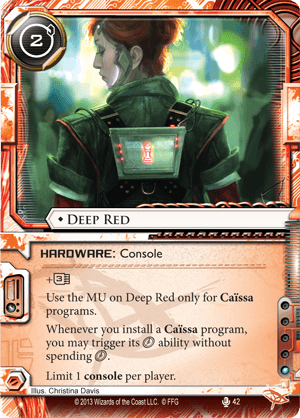
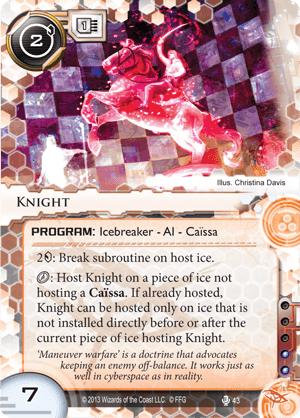
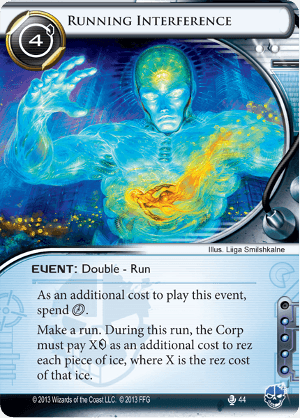
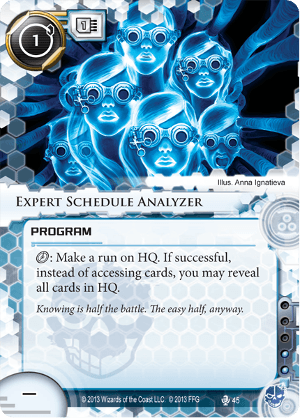
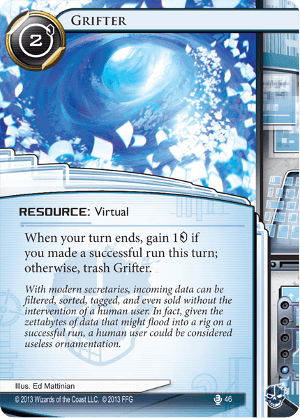
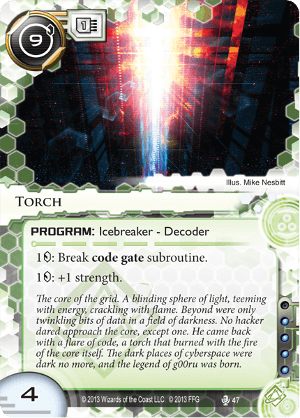
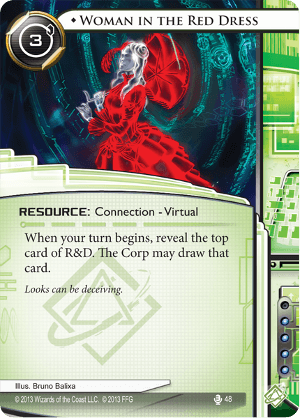
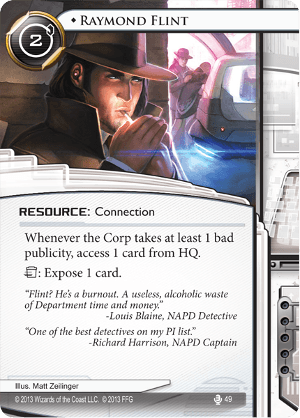
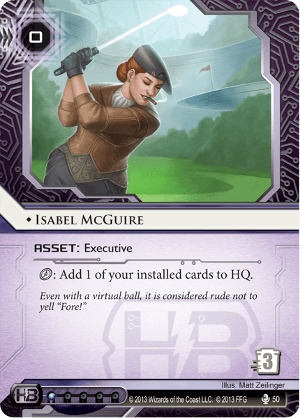
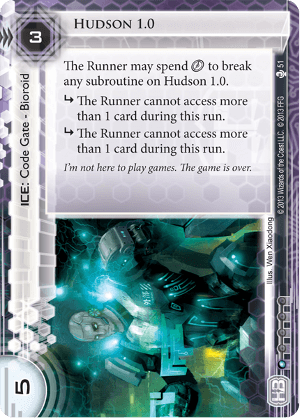
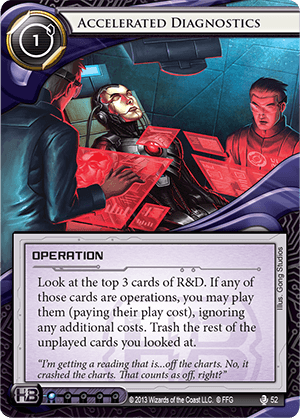
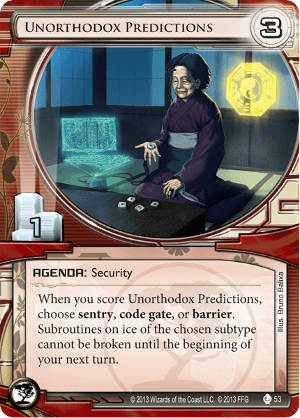
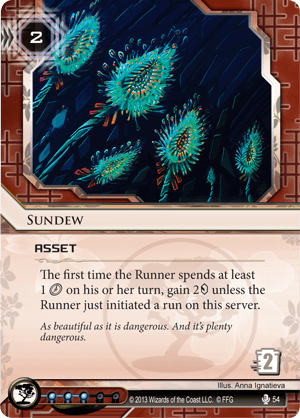
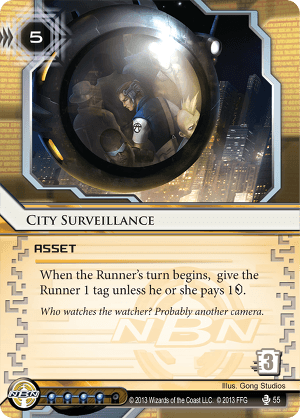
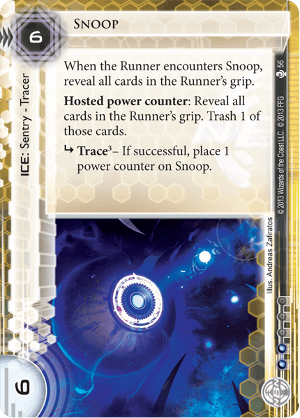
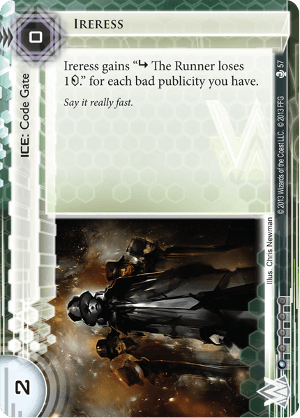
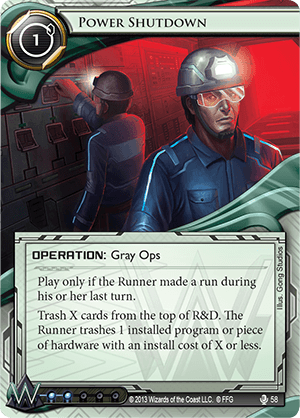
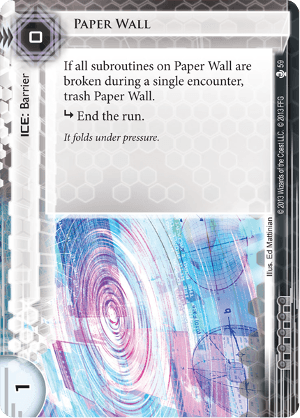

No comments:
Post a Comment